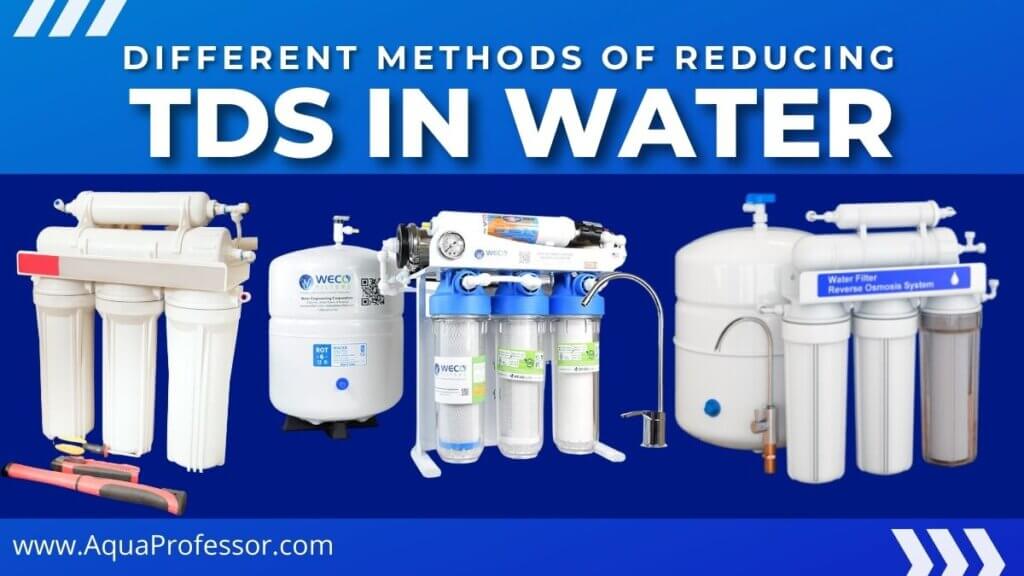
Total Dissolved Solids (TDS) are the total amount of dissolved solids in water. High TDS can imply the presence of harmful inorganic salts and deadly heavy metals like arsenic.
Reverse Osmosis is the best way to reduce TDS, as it pushes water through a semi-permeable membrane to remove over 95% of dissolved solids, including heavy metals and harmful impurities. Other reliable methods include distillation, ultrafiltration, and nanofiltration.
Continue reading for an in-depth guide on how to reduce TDS in water using practical methods.
How To Reduce TDS In Water Chart: When To Use RO?
| TDS Level of Water [mg/L] | Treatment Method | Installation and Maintenance Cost |
| <300 | UF + UV | You can get a UF Filter for about $50 and a filter cartridge for $20 (requires periodic replacement) |
| 300-900 | NF + UV | You can get a nano filter pitcher for about $46 |
| 900> | RO + UV | You can get a RO Filter for about $49 and pre-filters (needed to be replaced) for about $17. |
- How To Reduce TDS In Water Chart: When To Use RO?
- What Are The Different Methods Of Reducing TDS In Water
- What Is TDS In Water, And What Are The Best Ways To Measure TDS In Drinking Water?
- ✅What Is The Ideal TDS Level In Drinking Water?
- ❌What Are Harmful Effects Of Excess TDS In Drinking Water?
- Frequently Asked Questions
What Are The Different Methods Of Reducing TDS In Water
We have established that while some amount of TDS in water is necessary and acceptable, along with health benefits, high TDS levels are pretty harmful and need to be treated and eliminated before further consumption.
There are many ways to treat water with high TDS and lower the level. Here I have discussed the three most efficient ways to lower the TDS level in your water.
Using UF, NF, and RO Filters
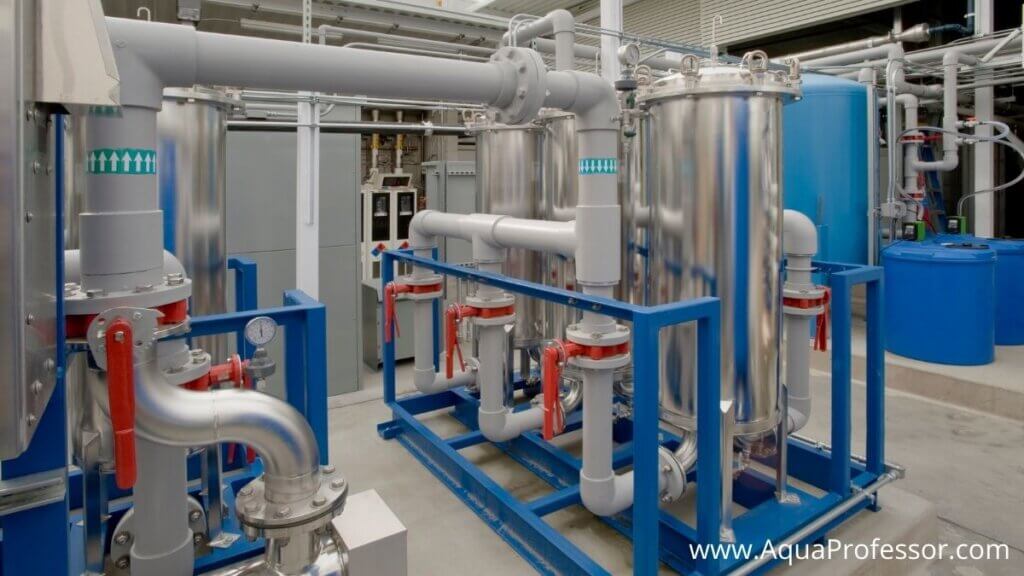
UltraFilteration Filters, NanoFilteration Filters, and Reverse Osmosis Filters are great ways to treat high TDS levels in the water.
UltraFilteration Filters work without using electricity. Here the water is made to pass through a hollow fiber membrane with a pore size diameter of 0.1 microns.
This method involves negligible water waste, and all the minerals are retained during ultrafiltration. However, this method is not suitable for hard water softening. It is an effective method for treating water with TDS levels less than 300 mg/L.
If you’re wondering how to reduce TDS in water without RO, Nano filters are the way to go. NanoFilteration filters use a semi-permeable membrane which the water is passed through. The membrane has a pore size diameter of 0.001 microns and is very efficient in water filtration.
This process is a little more precise than ultrafiltration. Even here, the minerals are retained, but Nanofilteration is efficient in removing the hardness of water up to 60%. Although, it may lead to a bit of wastage of water during the filtration process.
Nanofiltration effectively treats tap water with TDS ranging from 300-to 900 mg/L.
If your problem is high TDS levels in well water and you’re wondering how to reduce TDS in well water, reverse osmosis systems are your solution. A reverse osmosis filter or water purifier is the most commonly used filtration technique to treat water with high TDS levels.
Reverse Osmosis systems are a robust method of filtration, and they are very effective in removing all sorts of contamination and impurities from water. Reverse Osmosis filters have a semi-permeable membrane with a pore size diameter of as little as 0.0001 Microns.
It makes reverse osmosis very effective in removing all sorts of dissolved substances in water, giving out pure water for consumption. It can remove up to 90% of the hardness of water with ease. The downside is that it removes all sorts of minerals and impurities, so RO water may need to be remineralized after treatment.
Also, there is a great deal of water wastage during the process. You can use RO Filters to treat water with TDS levels higher than 900 mg/L.
Also Read: Why Your RO Is Constantly Draining [+How To Fix]
Distillation
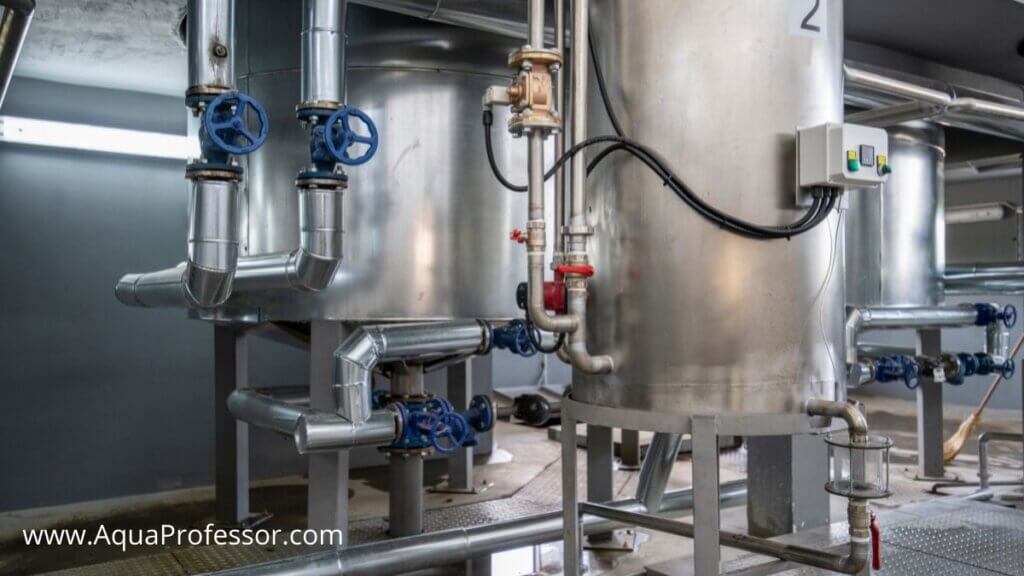
Distillation is another way to remove dissolved solids from water and obtain pure water. In this process, a water distiller is used, and water is evaporated, followed by condensation of the water vapors. As the dissolved solids do not evaporate, the vapors formed are of pure water, which is then turned into liquid form and is free from TDS.
While this method may provide you with pure water, it is rather inconvenient and time-consuming. Also, the efficiency is not much up to the mark either.
Also Read: Pros and Cons of Whole House Water Filters
Deionization
Deionization, as the name suggests, is the process of removal of ions in water to obtain pure water safe for consumption. In deionization, water is passed through a membrane with positive and negative electrodes. It works by the ion-exchange method.
The negative ions are retained by the positive electrode and the positive ions by the negative. This way, water is made free from ions or becomes deionized water. However, there is a prerequisite for this method. For any water to be deionized, it must be treated first via a Reverse Osmosis filter.
Also Read: Best Iron Filters For Well Water
What Is TDS In Water, And What Are The Best Ways To Measure TDS In Drinking Water?
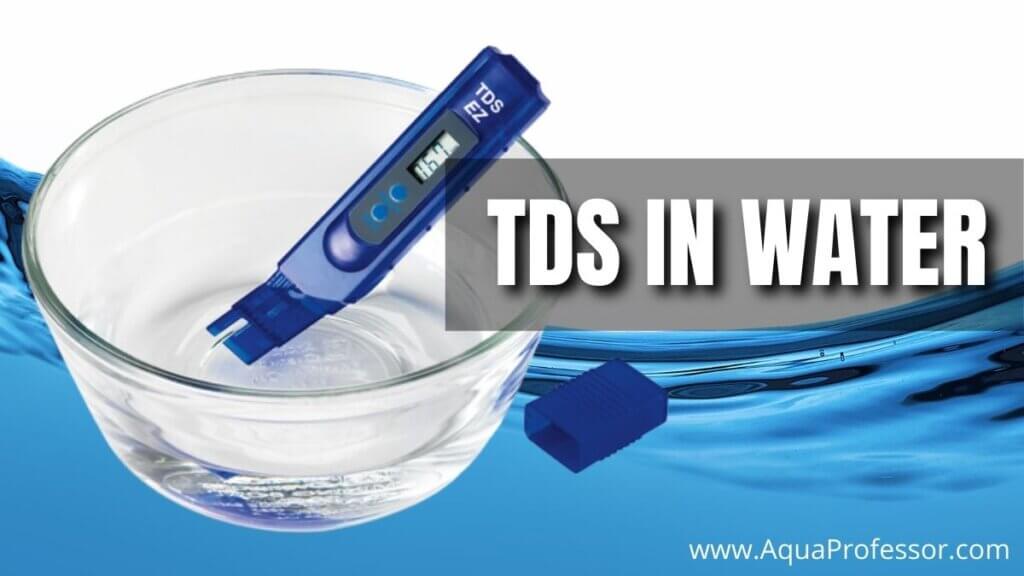
TDS stands for Total Dissolved Solids, which gives you the number of dissolved substances in a given volume of water, like minerals, salts, and ions. It is crucial as the amount of TDS in water significantly impacts water quality.
To some extent, TDS is necessary, but excess TDS in water becomes the root cause of many problems, including a bad and flat taste of water, significant health risks, etc.
TDS may not be considered a primary pollutant in water, but it is used to indicate the presence of harmful contaminants in your water source.
TDS could come from natural sources like agricultural run-off, human activities and residential wastes, industrial wastes, chemical emissions from industries into water bodies, and contamination from sewage treatment plants. It is a combination of organic and inorganic substances that contaminate water quality.
Also Read: 7 Best Ways To Maintain A Healthy Urinary System
TDS in water can easily be measured using TDS meters. The dissolved solids in water have ions in them. These ions can conduct electricity. The more electric conductivity of the water sample, the more dissolved solids it has.
An electric TDS meter works on this principle. It measures the amount of electricity conducted by the water sample and gives the relative value of TDS in it. The TDS levels are usually expressed in PPM or Parts Per Million units. TDS Meters can help you determine your water quality and give you a proper analysis for you to make an informed decision about your water consumption.
Keep in mind that TDS and TSS are two different things. While TDS is the Total Dissolved Solids, TSS is Total Suspended Solids. The difference here is that TSS are suspended solids, and you can easily remove them with filters. But TDS can not be eliminated via simple filtration as they easily pass through these filters because they are well dissolved in water.
✅What Is The Ideal TDS Level In Drinking Water?
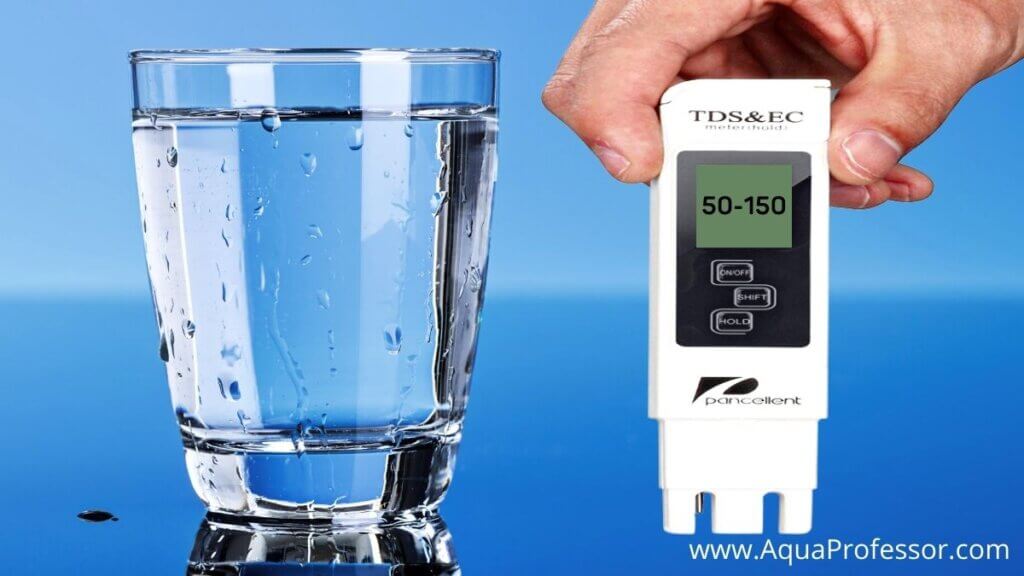
The presence of TDS in water may not necessarily make the water unfit for consumption. As mentioned earlier, TDS is the number of dissolved solids like minerals, inorganic salts, and sometimes hazardous chemicals in the water. Water without or completely lacking minerals or salt also makes it unfit for consumption.
To a certain extent, TDS levels are harmless and even necessary for the water to be considered fit and healthy. Water with TDS ranging between 100-300 mg/L is the ideal healthiest range and is perfectly healthy for consumption. Any water source with TDS less than 100 mg/L is demineralized water.
It may not affect human health or cause any significant health issues to your body. But such water lacks the essential minerals required for consumption, so it is better to add minerals to your water if it has low TDS levels.
Water with a 300-500 mg/L TDS is still permissible and falls under the acceptable range. It may not cause any significant damage to your health. Water becomes problematic when its TDS range exceeds 500 mg/L.
It means that for every one liter of water, there should not be more than 500 mg of dissolved solids in it. When TDS gets in excess and reaches the unacceptable range, the water must be treated appropriately before consumption to avoid severe medical complications.
❌What Are Harmful Effects Of Excess TDS In Drinking Water?
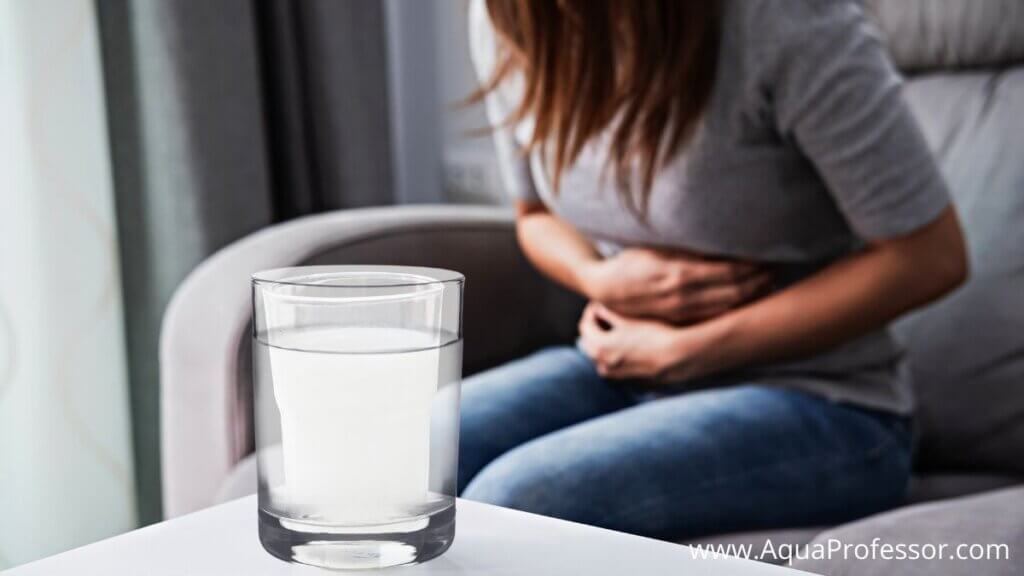
While mineral water with a certain TDS level can be helpful and essential for consumption, water with high TDS levels becomes harmful. High TDS levels in the water supply imply more concentration of natural minerals (Like calcium and magnesium), dissolved salts, ions, organic matter, etc.
Consuming water with higher TDS levels:
Hence, to avoid such complications, it is advised to treat the water with high TDS levels to make it fit and healthy for consumption.
Also Read: Frizzlife VS Waterdrop RO Filters
Frequently Asked Questions
Is high TDS water harmful?
Yes, drinking water with a high TDS level is unsafe. Filtration is needed to get rid of any particles in the water and make sure it is safe to drink. As the World Health Organization recommends, water’s total dissolved solids (TDS) level should be below 300 ppm to be consumed by humans.
Do water softeners reduce TDS?
Water softeners do not decrease the amount of total dissolved solids (TDS).
Water softeners only exchange calcium, magnesium, and iron ions or hardness minerals with sodium ions. They do not alter the presence of other dissolved solids like chlorides, sulfates, and organic matter in water. Still, other dissolved solids in the water may leave a film or residue when the water evaporates. Because of this, the TDS of hard and softened water won’t differ significantly.
What is the difference between TDS and TSS?
TDS in water, also known as Total Dissolved Solids, refers to the finer dissolved particles or solids in water, such as calcium, magnesium, chlorides, bicarbonates, and organic matter. They pass through 2-micron filters and are more harmful.
TSS, on the other hand, stands for “total suspended solids” and refers to those particles in water that can be held back by 2-micron filters. They are made of inorganic substances (such as clay, sand, minerals, and metals) and organic matter like microbes and algae. They are less harmful.
What causes TDS to be high in water?
The dissolved solids (TDS) in drinking water come from natural sources, wastewater, urban runoff, industrial discharges, chemicals & compounds used in the filtration process, and the pipes or plumbing used to transport the water.
Can boiling water reduce TDS?
There is no impact of boiling on the mineral composition of water or TDS. Boiling can only eliminate microbes and impurities whose boiling point is lesser than that of water (100ºC). Since dissolved solids like calcium have much higher boiling points, they stay in drinking water after boiling and pose health threats.
You should use an RO filter or distiller to reduce TDS effectively.
Adarsh is a Health & Nutrition Sciences graduate with expertise in environmental health. He is associated with ventures like Glacier Fresh Filter and Simpure Filter Systems. Through Aqua Professor, he intends to provide helpful information to every home to help them make smarter decisions.

Great article. Thank you!
Your welcome Randall!
Dear AquaProfessor,
I am on well water and I have measured TDS at about 450 – 500 ppm. I would like to significantly reduce that number for health reasons. As I am also looking at a combo Boiler / DHW unit that requires <500ppm TDS. Thus I am considering a whole-house system. There are 2 people in our house so our total water usage is limited.
I am interested in either the Nanofiltration or RO approaches you mention above. I see quite a few RO systems, but have not found many Nanofiltration systems. Can you recommend a manufacturer or specific Nanofiltration system? Also is it possible to easily contrast the ongoing cost of the two approaches? I am less concerned about the initial installation cost.
I would be indebted for any information you might be able to share!
I could recommend Waterdrop for RO+NF systems but do remember that TDS doesn’t indicate water quality. See the presence of excess minerals (hardness, iron, sulfur) or contaminants like E.coli and then decide what treatment unit you need.